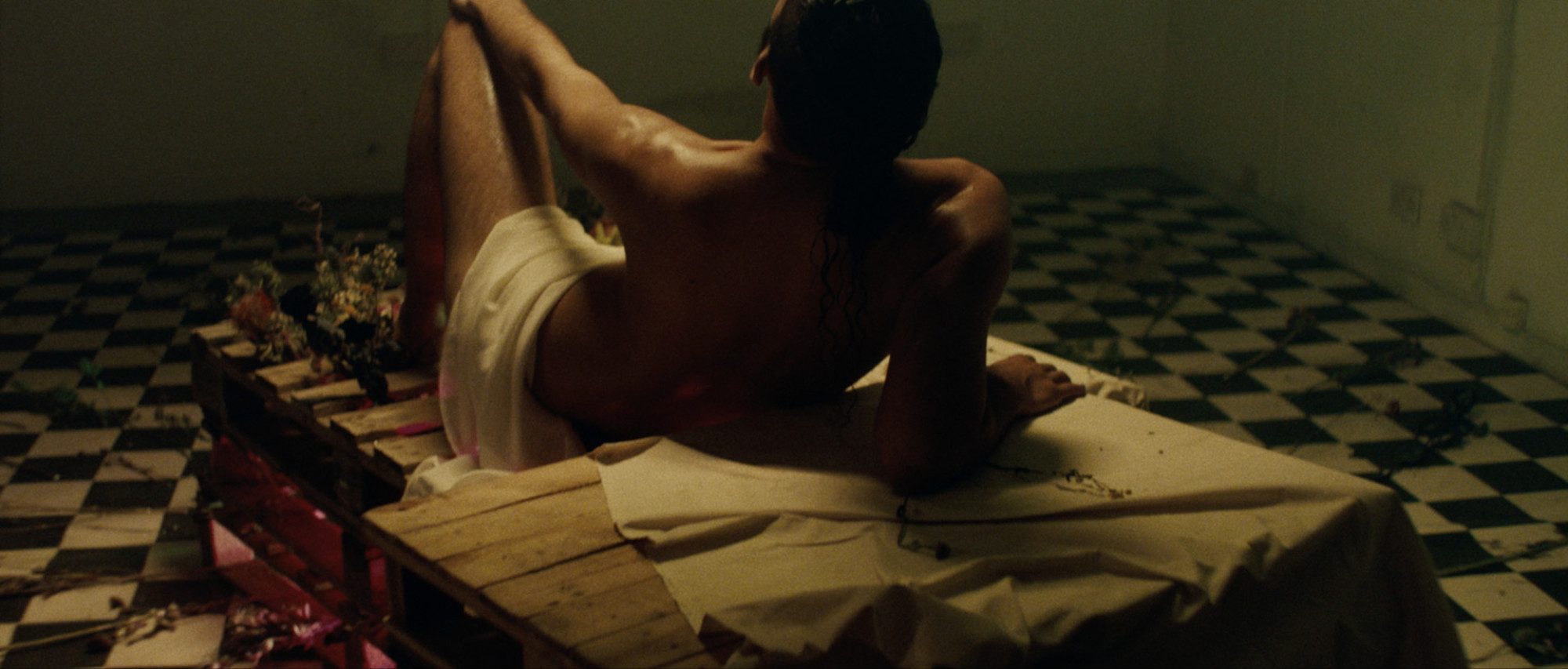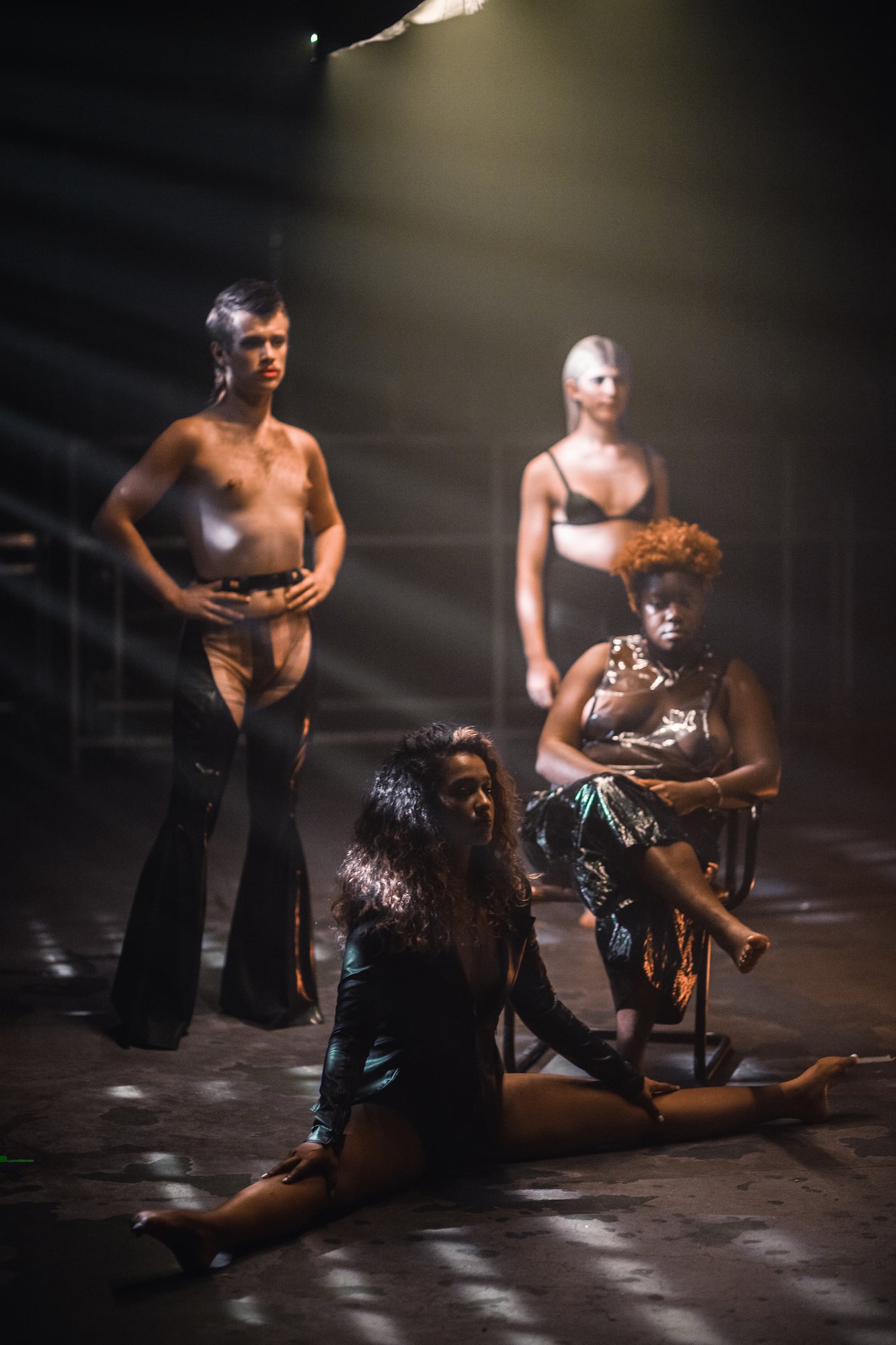
When did the roots of gender begin? How do we perceive gender through classical art? These are the questions that permeate the music video-esque images of Emmanuelle Soffé’s Neo Gender, which questions the binary concept of ‘gender’ from a historical, cultural and a biological perspective. A visually arresting subversion of traditional representation in Western art accompanied by searching synths and polemical voiceover, this sexy, expressively-lit film points to a future world with a far more inclusive and broader understanding of gender. DN caught up with Soffé to talk about her art history background, making the film feel inclusive and the issues trans people currently face in the UK.
Your film recreates classic paintings such as Death of Murat by Jacques-Louis David and sculptures such as Sleeping Hermaphroditus by Gian Lorenzo Bernini. Why did you decide to look at the film through this framework and what was the challenge of re-creating it?
I come from a family of artists and I studied art history, so I have this natural tendency of seeing everything through the lens of artwork and architecture. The challenge wasn’t necessarily in recreating the classical works, it was more in being able to articulate that connection to the viewer because you can’t always assume that everyone watching has an art history degree. So I had to strike that balance between putting in my references with making the film accessible. What I did in the end was put a tiny title in the right hand corner, so at least the person watching is aware something’s going on there and if they’re curious they might Google it.
The film’s unity is established through a voiceover that questions conventional gender standards. Did you write this yourself? Was it based in any particular theories?
I conceived of the idea for the voiceover, including the mimicking of the old testament. I wanted to reclaim the ultimate symbol of Abrahamic religions and turn it on its head. I want to make it clear that’s it’s not disrespectful of these religions. It’s simply a rereading (of the Biblical texts). Although I came up with the initial idea I didn’t actually write the voiceover myself. I felt it was important to ask two wonderful writer-friends of mine, Grace Tully and Donna Marcus, who both identify as non-binary. Although I do consider myself to be gender fluid, I felt it was important that the voice of the film didn’t come from someone, like myself, who is cis-presenting and therefore benefits from cis-privilege. That’s not to mention they are many times more talented than me at writing.

So, it’s interesting you mentioned this basis in religion, because Adam and Eve is something of the ultimate gender binary…
Yeah, exactly! I can’t help but feel that the dawn of Abrahamic religion is that moment in history where there begins to be a very distinct gender binary. What I wanted to do was go back to the roots of transphobia in general, which is that point where we became a lot more fixed in terms of our categories of gender, then almost try to make amends through the script.
I wanted to reclaim the ultimate symbol of Abrahamic religions and turn it on its head.
You come from an art history background. How has the depiction of gender changed over the years in art?
I’d probably have to write you a book to do this question justice. There are two things to say before attempting to answer. First: the concept of ‘art’ is relatively new. Four or five hundred years ago, what we now view as art in a museum would have been considered in an entirely different framework, such as a religious offering or a way for the church to ‘educate’ those who couldn’t read. Therefore the way we approach these pieces of visual material is already through a different lens from how it was initially intended.
Secondly, within discussions of ‘art’ today, we automatically adopt a Eurocentric perspective, the classic artistic timeline, beginning with the Ancient Greeks, progressing to the Roman Empire, through the dark ages and medieval period, then the sudden burst of art of the Italian Renaissance, up to the many movements that came up to the contemporary art of today. The Eurocentric model is how Western museums curate their collections: it is, to put it bluntly, a romanticised re-construction of history, not to mention one steeped in white supremacy!

The large majority of visual material from around the world don’t make it into this Eurocentric model of art. So to answer your question, you’d first have to decide what your definition of art is, and you’d have to acknowledge that there is a lot of visual material that has been overlooked by Western academia.
What I will say is that there is a lot of evidence to show that the dawn of Abrahamic religion, particularly Christianity, was the beginning of clear distinctions between male and female. Those who weren’t strictly male or strictly female were a normal and accepted part of society. There certainly were not the stigmas and prejudices attached now to those who do not fit perfectly into a gender binary.
It felt fitting to shoot this film in a space that understands, respects and protects the LBGTQ+ community.
You filmed in Fold nightclub in London. What was it like filming in this space?
If you’re into electronic music, you know that Fold is one of the most highly respected electronic venues in London. It’s always been an open and safe environment for queer people, so naturally it felt fitting to shoot this film in a space that understands, respects and protects the LBGTQ+ community, not to mention the fact that it’s a stunning venue.



So the film has a lot of expressive compositions that really jump off the screen. Tell me about how you set up the scenes!
I can’t really take full credit for the lighting because I worked so closely with my DOP Adam Singodia. I always describe to him what I want to the scenes to look like and he goes away and creates everything that I want. I really like to blend colours and do things unconventionally and use unusual light sources, like the laser beams that hit one of our talent’s bodies. Adam used an Arri Alexa Mini and Zeiss Super Speed Lenses. He’s just a pro with lighting and keeps my visions within reason.
The film ends with the line, “What if we built this all wrong?” Would you say there is a problem in the UK when it comes to trans issues?
Yeah. We’re a long way from living in a country with fair and equal rights for trans people and that’s really sad. For a non-cis or trans person, even something as small as going to the shop can be an ordeal. And these things are up for debate by those who think they are entitled to speak on their behalf. I think in life when we make a decision, whether big or small, we should ask ourselves: “Are we giving something to the world or are we taking away from it.” It’s quite an important thing to be conscious of. When people debate the existence of a trans person, I always think: “Why do you care so much. You’re not losing anything by letting a trans person be who they want to be.” Attempting to prove you are right should never come ahead of the safety of a person.
We’re a long way from living in a country with fair and equal rights for trans people.
This follows Neo-Privilege. Are you making a Neo-series? What else is planned?
So I made two Neo films. I decided for the moment that I’m going to put this project to rest and focus on other ideas I have. I initially wanted to make an entire series. I wanted to have Neo-Woman and a Neo-Cultural Appropriation. Upon reflection, I don’t think as a white person it’s necessarily my place to make a film about cultural appropriation. I’d very happily hand the project over to the right person if they wanted to make it. The Neo-series is not about me, it’s about these topics. So if the right person came I’d like to do that.
What else are you working on next?
I’ve just finished filming my first music video last weekend. It’s a film about two female friends who very clearly fancy each other a huge deal but just can’t quite figure out if it’s a friendship or something more. I feel like bisexual narratives are something I want to focus on in my work in the future and definitely something that is underrepresented even now within queer cinema.


